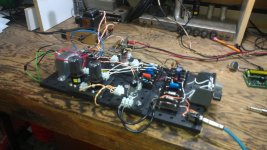Bassman (various types) Preamp Questions
Trying to figure it out... Both normal and bass inputs go thru tone stacks, but the bass channel has a 3rd gain stage, with a voltage divider/filter/? on it's grid.... What gives? Does the bass tone stack need more recovery gain? What happens to the input to the 3rd gain stage? Thanks!
Trying to figure it out... Both normal and bass inputs go thru tone stacks, but the bass channel has a 3rd gain stage, with a voltage divider/filter/? on it's grid.... What gives? Does the bass tone stack need more recovery gain? What happens to the input to the 3rd gain stage? Thanks!
Last edited:
Found this on a forum: "The pair of 220K resistors form a voltage divider. They are the same value resistors, so half the input voltage is shunted to ground and half is send to the input grid of the next tube. The cap is a filter to control what frequencies are passed or filtered out to shape the tone further. Sorry, I'm not good with how caps filter frequencies. Someone else with better technical chops than me needs to explain that bit of it.". Makes sense to me. Poster also stated the best Bassman he ever heard had an AB165 preamp and an AA864 power section (the AB165 has some bizarre features). Am still researching and learning!
Look at the model history: Some Bassman amps have featured a somewhat different tonestack in the bass channel, usually with one control being substituted with fixed" value resistors and then implemented as a separate user controllable filter elsewhere in the preamp. Being passive it usually needed some additional gain to compensate signal losses.
In AA864 the tonestack arrangement is more "traditional" but rest of the circuit configuration and "gain staging" still copied from earlier models where it wasn't, namely the "Brown" models 6G6 (A, B, C, etc.). Now they simply tame most of the gain within that "recovery circuit" since there were no additional losses from tone controls post the "tonestack".
As said, study the different model schematics in chronological order, and why not even reference to other Fender models from the era too. They usually shows certain "evolution" and it usually explains a lot of oddities and circuit design decisions.
Brownface Bassman 6G6:

Notice separate treble control post tonestack needing more gain to compensate losses
...Followed by Blackface Bassman AA864:

Bass channel's "gain staging" design pretty much the same (sans follower driving the stack). Now the stack features both controls, so treble control is erased from further down the signal path and gain of the later stages attenuated.
...Followed by Blackface Bassman AB165:

Now simplified even further. The somewhat "un-needed" gain stages removed, now it's just gain stage, stack and recovery gain stage on both channels terminating to a common mixer stage.
In AA864 the tonestack arrangement is more "traditional" but rest of the circuit configuration and "gain staging" still copied from earlier models where it wasn't, namely the "Brown" models 6G6 (A, B, C, etc.). Now they simply tame most of the gain within that "recovery circuit" since there were no additional losses from tone controls post the "tonestack".
As said, study the different model schematics in chronological order, and why not even reference to other Fender models from the era too. They usually shows certain "evolution" and it usually explains a lot of oddities and circuit design decisions.
Brownface Bassman 6G6:

Notice separate treble control post tonestack needing more gain to compensate losses
...Followed by Blackface Bassman AA864:

Bass channel's "gain staging" design pretty much the same (sans follower driving the stack). Now the stack features both controls, so treble control is erased from further down the signal path and gain of the later stages attenuated.
...Followed by Blackface Bassman AB165:

Now simplified even further. The somewhat "un-needed" gain stages removed, now it's just gain stage, stack and recovery gain stage on both channels terminating to a common mixer stage.
Last edited:
Thanks for all the detailed comments! I do like the AB165 preamp - makes the most sense. It's the power section of this version that has too many wierd things in it (feedback on the power tubes, OT feedback thru a capacitor to the grid of the PI tube, etc). But that's on my other thread (6V6/6L6 switchable..). I'm breadboarding it now, using a basic Fender preamp (Champ, Deluxe) and configurable tone stack. Will add an LTP/pwr board to it, get it up and running, and then play with the preamp. Thanks again!
Attachments
Last edited:
- Status
- Not open for further replies.
